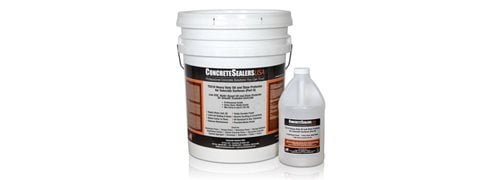- Concrete Sealer
- Comparison Chart of Concrete Sealers
- Buying Tips for Concrete Sealer Products
- Concrete Sealer Reviews: Sealer products other contractors use and recommend
- Common Questions about Concrete Sealers
- How to Remove Concrete Sealer
- Types of Sealers
- Acrylic Sealers
- Epoxy Sealers
- Penetrating Sealers
- Polyurethane Sealers
- Polyaspartic Sealers
- Application Surface
- Driveway Sealer
- Patio Sealer
- Pool Deck Sealer
- Sealers for Stamped Concrete
- Concrete Floor Sealers
- Concrete Countertop Sealers
- Pool Deck Sealer
- Exposed Aggregate Sealer
Penetrating Sealers for Concrete
Penetrating sealers provide excellent protection against outdoor conditionsPenetrating sealers, such as silanes, siloxanes, silicates and siliconates, penetrate into the concrete to form a chemical barrier that shields against moisture penetration and deicing chemicals. Usually they provide invisible protection without changing the surface appearance, and most products are breathable, allowing moisture vapor to escape. They are most commonly used outdoors, since they provide excellent protection against harsh exposure conditions.
Applications
A penetrating sealer is your best choice if your goal is to:
- Protect exterior concrete surfaces subject to corrosion and freeze-thaw damage.
- Obtain a natural, matte finish.
- Provide invisible protection without changing the surface appearance or leaving a sheen.
For driveways and walkways where good traction is important, a penetrating sealer is a better choice than a film-forming product, such as an acrylic or polyurethane. Because a penetrating sealer does not leave a glossy film, it will not contribute to the slipperiness of the concrete surface.
How to apply
- Low-pressure, high-volume sprayer
- Pump-up garden-type sprayer
- Roller
Related resources:
Choosing the Best Applicator for Concrete Sealer
Advice on Choosing and Applying Sealers
 D-One Penetrating Sealer
Non-yellowing, low sheen, good adhesion
D-One Penetrating Sealer
Non-yellowing, low sheen, good adhesion
 Deep Penetrating Sealer
RadonSeal - Waterproofs & strengthens.
Deep Penetrating Sealer
RadonSeal - Waterproofs & strengthens.
 Clear-Seal by Increte Systems
Seals and protects decorative surfaces.
Clear-Seal by Increte Systems
Seals and protects decorative surfaces.
 Heavy Duty Oil & Stain Protector
TS210 - 4 gal. kit ($439.95)
Heavy Duty Oil & Stain Protector
TS210 - 4 gal. kit ($439.95)
 Gem-Guard SB
Penetrating sealer that protects against salt damage
Gem-Guard SB
Penetrating sealer that protects against salt damage
 Decorative Sealers
Reactive and penetrating formulas in various levels of gloss.
Decorative Sealers
Reactive and penetrating formulas in various levels of gloss.
 Water Repellent Penetrating
Sealer for driveways, parking structures, plazas, walkways & more.
Water Repellent Penetrating
Sealer for driveways, parking structures, plazas, walkways & more.
 Clear Acrylic Concrete Sealer
$219.30 (5 gal.)
Clear Acrylic Concrete Sealer
$219.30 (5 gal.)
 Colored Concrete Sealer X-4
High gloss finish available in 20 colors
Colored Concrete Sealer X-4
High gloss finish available in 20 colors




